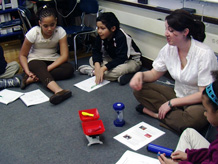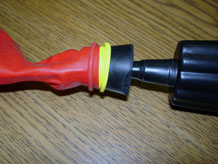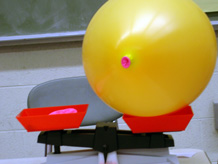Is air matter?
3. Weigh balloons
The Weight of Air
If you scoop a cup of water out of a large pot you can feel its weight. If you pour that water back into the pot, you would not expect that weight to cause the water to sink to the bottom of the pot and stay there, as if it were a rock. The water from the cup will mix in with and drift through the rest of the water as if it were weightless, because it has the same density as the water in the pot.
For the same reason, any specific quantity of air in the atmosphere appears to be weightless. However, air does have weight. Air pressure, which we hear about in weather reports, results from air's weight. Since we live with air pressure all around us, and even inside of us (e.g., lungs) we do not sense it. Even scales do not sense the weight of air, because they are completely surrounded by air pressure.
One way to demonstrate that a sample of air has weight is to make it denser than the surrounding air. It that case, the sample will sink in the atmosphere. Cold air is denser than warm air; more particles are packed into each cubic centimeter. Open the freezer door and you'll feel the cold air spilling down towards the floor. Compressed air is denser than uncompressed air, with more particles packed into each cubic centimeter.
Why a double balloon?
A balloon resists being stretched, so as it is inflated it compresses air particles closer together, making that air more dense than the uncompressed air in the room. A double balloon offers even more resistance to being inflated, and compresses the air particles even closer together, making the enclosed air dense enough for a balloon-sized quantity to tip the pan balance.
Students may not need this much information. The demonstration speaks for itself.

Remind students that if air is matter, it must have weight. A question is:
- No, you can't feel air and it doesn't register on a scale.
- Yes, because my soccer ball feels heavier after I pump it up with air.
What positions do students take? Be sure to hear from students with positions on each side of the question. Ask students to make a claim and to provide the evidence or reasoning on which their claim is based.

Show students the uninflated double balloons placed on each side of the double pan balance. Point out that the two sides balance and so there are equal weights on both sides. Next, ask students to imagine that the balloons on one side of the balance are inflated.
- What will we observe if air doesn't weigh anything?
- What will we observe if air does have weight?
Use the balloon pump (with the rubber stopper) to inflate one set of doubled balloons to its full size. Using a balloon pump to inflate a balloon avoids adding moisture from your lungs into the balloon, which in turn helps to establish the fact that "dry" air has weight.

Tie off the opening of the inner balloon and return the inflated double balloon to the double pan balance. The pan with the inflated double balloon will move down.
Do we have evidence that air has weight?
Students record their responses on the [Does air have weight?] page in their Science Notebooks.



